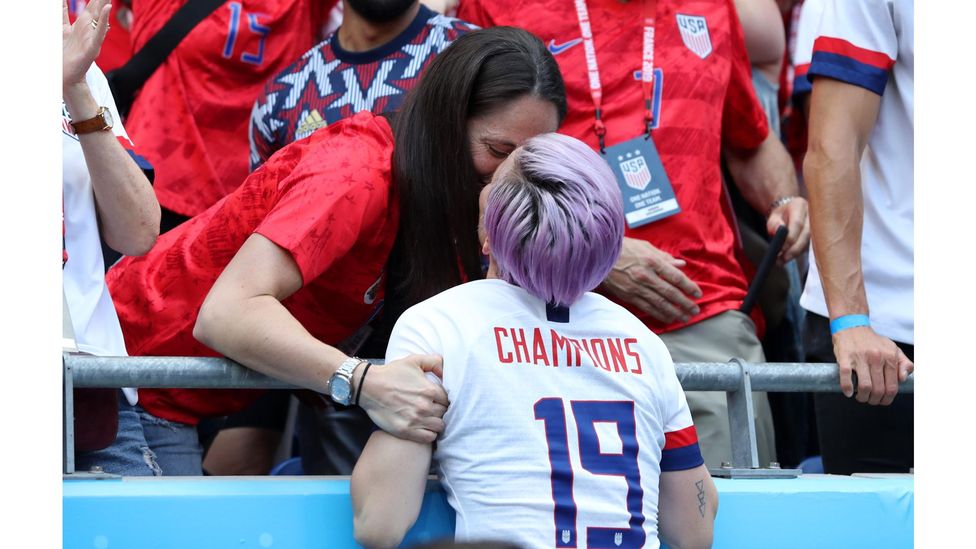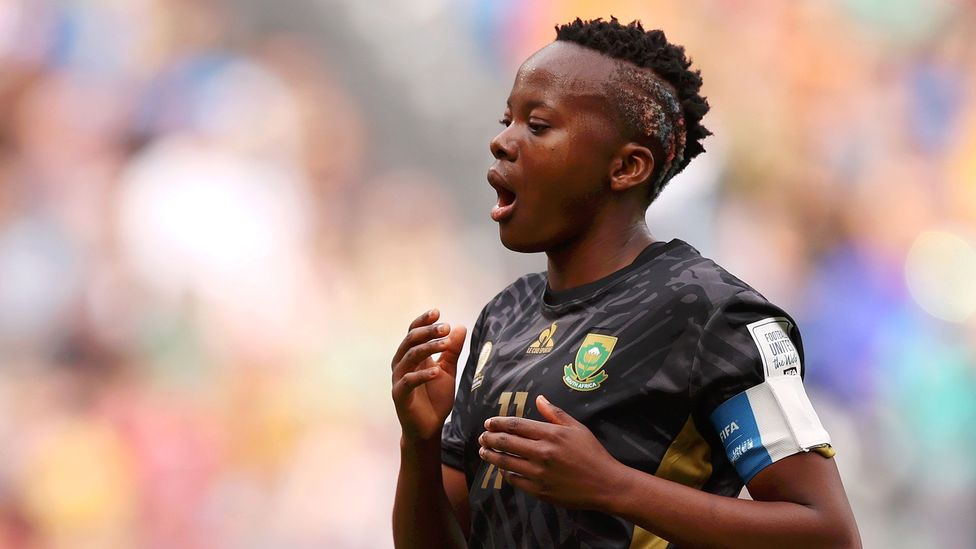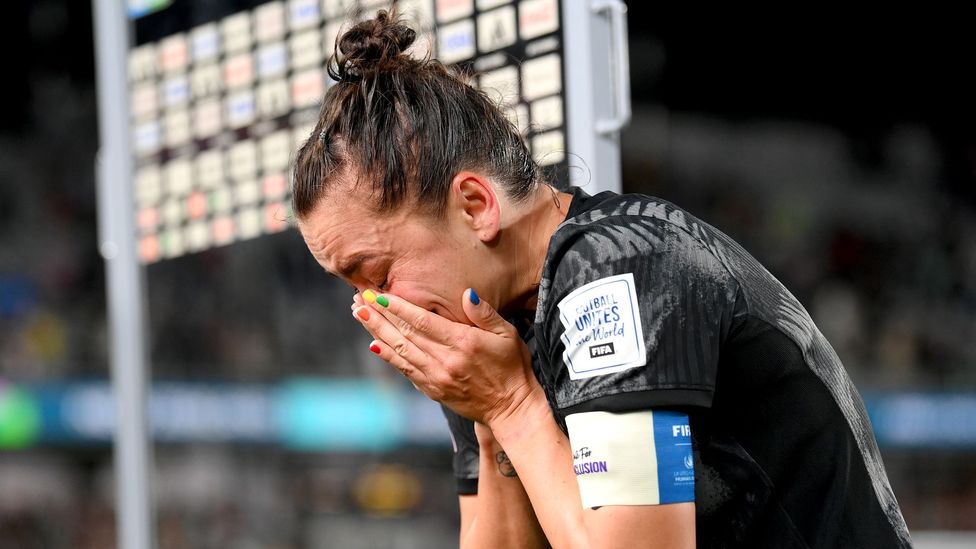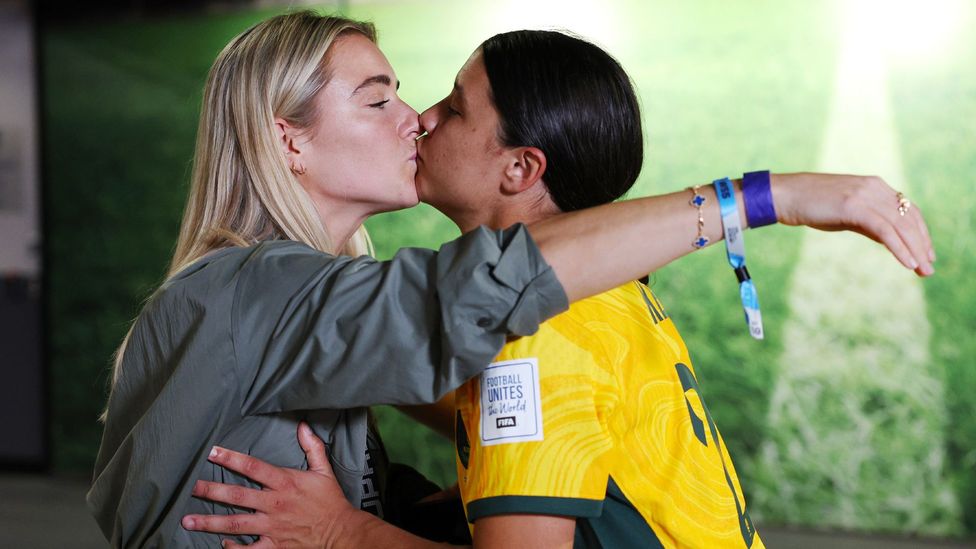Immediately after winning the 2019 Fifa Women’s World Cup game against the Netherlands, now-retired champion Megan Rapinoe ran towards the sidelines and kissed her long-time girlfriend, WNBA star Sue Bird. The moment was seen around the world – and it took the visibility of the LGBTQ+ community to a new level.
Rapinoe is not the first openly gay football player – that was Lily Parr in the 1920s – and more than 96 athletes in the 2023 Fifa Women’s World Cup are out today. Experts and viewers alike say the door has increasingly swung open for LGBTQ+ athletes to express their true selves.
They are eagerly walking through it. This year, the competition has become a display of inclusivity and representation.
TikTok influencer Jackie J (@jcubehax) refers to this series as “good, queer joy”. Throughout the Women’s World Cup, Jackie J has posted videos of the best moments of the games and sideline romances, including a dramatic montage of the controversies, plays and relationships in the Spain v Netherlands knock-out round; and a heart-warming proposal to Australia’s Emily van Egmond by girlfriend Kat Thompson after a 4-0 win against Canada.
Glennon Doyle, who co-hosts the podcast We Can Do Hard Things with retired US soccer star wife Abby Wambach, has been tweeting live Women’s World Cup updates, too. As the US struggled to score against Portugal on 1 August, she posted: “Maybe let’s try more lesbians on the field after intermission”. (The game ended in a 0-0 draw.)
Regardless of the score lines throughout the competition, increased representation – both through displays of athlete affection as well as these fan moments touted online – is making an impact on the game. And it’s having ripple effects of inclusivity, far off the pitch.

Megan Rapinoe's kiss with then-girlfriend Sue Bird in 2019 was a landmark moment in LGBTQ+ visibility (Credit: Alamy)
A platform for visibility
In a 2017 essay for Outsports, a site that covers LGBTQ+ issues and news in the sports community, footballer Hannah Wilkinson – who scored the first goal of the 2023 Women’s World Cup, marking the first victory for New Zealand in both women’s and men’s competition – wrote about the importance of using her platform as a pro athlete to advocate for inclusivity.
An increasing number of LGBTQ+ athletes are doing the same. It’s a change from the past, as athletes have historically had to conceal their sexual identities for fear of harassment and discrimination.
Researchers from the US Center for American progress suggest half of gay, lesbian and bisexual players hide their sexual identities from their teams. Yet change is evident – with women players leading the charge. In a strong show of representation, roughly 13% of players in the 2023 Women’s World Cup identify as LGBTQ+. Outsports reports Australia leads the way with 10 openly gay players, which Jackie J dubs "The Gayest Team 2k23".
While there is already a certain level of acceptance in countries including the United States, players from more historically conservative countries, such as Colombia, are now out about their sexual identities on the field, too.
Sarah Axelson, vice president of advocacy at the Women’s Sports Foundation, parallels the shift in sport to the larger cultural move towards acceptance. “Sports is often a microcosm of society, so it makes sense that we’d see acceptance and visibility grow in sports, too”.
A now-viral clip from Jackie J’s TikTok, showing Colombia captain Daniela Montoya celebrating in a sidelines embrace with girlfriend Renata Arango after their 2-1 win against Germany is emblematic of this rising visibility. It wasn’t only displays of queer affection; Canadian midfielder Quinn also made history by becoming the first ever transgender or non-binary person to play at either a men or women’s World Cup.
“As we see more athletes live and love authentically,” says Axelson, “they continue to help shift culture both on and off the pitch.”

Thembi Kgatlana of South Africa was one of the many players during the 2023 Fifa Women's World Cup to show pride and solidarity (Credit: Getty Images)
Better visibility, enduring challenges
Outside football, queer visibility is growing around the world.
A 2022 Gallup poll showed the number of people who openly identify as LGBTQ+ in the US has more than doubled throughout the past decade, now at 7.2%. And in the UK, 2021 census data showed more than 1.3 million people in England and Wales identify as lesbian, gay or bisexual. LGBTQ+ data expert Kevin Guyan, a research fellow at the University of Glasgow called the data a "landmark moment for inclusion" upon its release. Younger generations are increasingly more comfortable with visibility; an Ipsos survey revealed one in five Gen Z adults identify as LGBTQ+ – more than any other generation.
However, the LGBTQ+ community around the world still faces hurdles proudly coming out about their sexual orientation, with 71 countries criminalising LGBTQ+ acts.
And even for those people who are comfortable being out, issues such as harassment and discrimination abound. A 2021 report from the Williams Institute at UCLA School of Law showed that in the US, 46% of people who identify as LGBTQ+ say they have received unfair treatment because of their sexual orientation. And in the corporate world, once surging DEI programmes are taking a hit amid mass layoffs.
Yet globally, as the fight for LGBTQ+ acceptance continues, more athletes are stepping up and speaking out. For instance, FIFA banned the OneLove Pride armbands during the Men’s World Cup last year in Qatar, where it’s illegal to be gay. But this year, Women’s World Cup players are finding creative ways to show solidarity.
New Zealand captain Ali Riley painted her nails the colours of the gay pride flag on one hand and the transgender flag on the other. South African forward Thembi Kgatlana dyed her hair the colours of the Pride flag; and Philippine forward Sarina Bolden, who scored the first ever World Cup goal for her team, winning the match against New Zealand, touts in her Instagram bio, “I just want to have fun and b gay.”

Ali Riley of New Zealand painted her nails the colours of the Pride flag during the competition (Credit: Getty Images)
Women may be uniquely positioned to further this fight for visibility.
Men’s professional sports are often referred to as "the last closet". They thrive on a specific expression of masculinity, leaving little room for expansive identities. Sports “historically developed as a mechanism to socialise boys and young men into culturally appropriate and socially expected norms, values and roles,” says Cheryl Cooky, a professor of women's gender and sexuality studies at Purdue University, US, and co-author of Serving Equality: Feminism, Media, and Women’s Sports. "As such, modern sports serve as a key cultural site for the maintenance of masculinity.”
Yet as women’s sports already exist outside of those norms, female athletes are ahead of the game in terms of breaking free from them. It’s helped them in their tough fights for recognition, including equal pay and the right to play on grass instead of turf – high-profile battles that have left a lasting mark on inclusion and equality in the game.
There’s still a long way to go, but experts, fans and athletes themselves are optimistic about progress. During a press conference, Australia defender Ellie Carpenter confirmed this saying, “How far we’ve come is just unimaginable. I’m so proud to be part of this generation.”
Axelson adds that progress is needed on an international level, “but it’s still possible, especially with women at the helm”.
